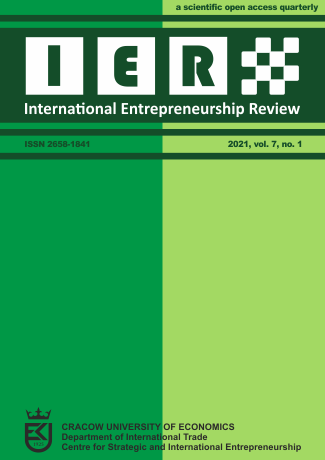The relationships between the macroeconomic situation and European skyscrapers

Abstract
Objective: The aim of this paper is to verify if economic prosperity is related to the number of skyscrapers built and their average height. It was done by examining the dependencies between GDP growth rate, unemployment rate, the Gini coefficient and the skyscrapers variables mentioned.
Research Design & Methods: In order to investigate the relationship between the number of completed skyscrapers, their average height, and year, a correlation was used. Linear regression was used to verify the relationship between macroeconomic variables and those relating to skyscrapers. The macroeconomic data were obtained from the World Bank, IMF, and WTO databases, and the data referring to skyscrapers – from Emporis.com.
Findings: The time variable (year) was positively correlated with the analyzed variables linked to skyscrapers. The research showed a negative impact of the unemployment rate and a positive impact of the Gini coefficient, on the number of completed skyscrapers. Further, the economic growth was negatively and Gini coefficient values were positively related to the average height of skyscrapers.
Implications & Recommendations: This study allows determining the periods in which an increased construction of skyscrapers could be expected. It may be useful for investors, global corporations or potential developers.
Contribution & Value Added: The analysis provided empirical confirmation of the hypotheses about the positive correlation between the number and average height of skyscrapers and the degree of economic inequality. Also, the negative dependencies between the number of these structures and the unemployment rate and between the average height of completed skyscrapers and the GDP growth rates, based on the example of European countries, were found.
Keywords
skyscrapers, economic growth, GDP growth rate, unemployment rate, Gini coefficient
Author Biography
Bartłomiej Pilch
Bachelor in Economics and Finance. Currently Master Student of Economics and Finance at Cracow University of Economics (Poland).
References
- Ahlfeldt, G. M., & Barr, J. M. (2020). The Economics of Skyscrapers: A Synthesis. Centre for Economic Performance Discussion Paper, 1704.
- Al-Kodmany, K. (2018). Skyscrapers in the Twenty First Century City: A Global Snapshot. Buildings, 8(12). https://doi.org/10.3390/buildings8120175.
- Barr, J. M. (2016). Building the Skyline: The Birth and Growth of Manhattan’s Skyscrapers. Oxford University Press.
- Barr, J. M. (2017). Regression Results for Skyscraper and Height Happiness. Retrieved February, 28 from https://buildingtheskyline.org/wp-content/uploads/2017/12/Blog-6-Data-and-Regressions.pdf.
- Barr, J. M., & Johnson, J. (2020). Skyscrapers and the Happiness of Cities. Eastern Economic Journal, 46 (8), 344-377. https://doi.org/10.1057/s41302-019-00163-2.
- Barr, J. M., & Luo, J. (2020). Growing Skylines: The Economic Determinants of Skyscrapers in China. The Journal of Real Estate Finance and Economics, https://doi.org/10.1007/s11146-020-09764-7.
- Barr, J. M., Mizrach, B., & Mundra, K. (2011). Skyscraper Height and the Business Cycle: International Time Series Evidence. Rutgers University Newark Working Paper, #2011-003.
- Barras, R. (1994). Property and the Economic Cycle: Building Cycles Revisited. Journal of Property Research, 11(3), 183-197. https://doi.org/10.1080/09599919408724116.
- Begeç, H., & Hamidabad, D. S. (2015). Is There a Limit for the Skyscrapers?. 9th International Sinan Symposium, Edirne. 9.
- Emporis (2021). Europe. Retrieved from https://www.emporis.com/ on February 28, 2021.
- Formaneck, S. D. (2013). Skyscrapers and Economic Strategy of Development: The Case of Bahrain’s Proposed Murjan Tower. Journal of Economics, Business and Management. 1(4), 350-354. https://doi.org/10.7763/JOEBM.2013.V1.76.
- Heo, J.-Y., Kim, H.-J., & Jung, Ch.-M. (2013). Effects on Business Cycles by Constructing Skyscrapers in Seoul. Journal of the Architectural Institute of Korea Planning & Design, 29(6), 213-221.
- World Health Organization (2020). Indicators – the Gini coefficient. Retrieved from https://gateway.euro.who.int/en/indicators/hfa_617-0280-gini-coefficient-income-distribution on February 28, 2021.
- Jadevicius, A. (2016). Skyscraper Indicator and its Application in the UK. Entrepreneurial Business and Economic Review, 4(2), 37-49. https://doi.org/10.15678/EBER.2016.040204.
- Kachniarz, M. (2014). “Skyscraper index” – czy wieżowce wieszczą krach?. Zeszyty Naukowe Uniwersytetu Szczecińskiego, Studia i Prace Wydziału Nauk Ekonomicznych I Zarządzania, 37(3), 21-31.
- Kaza, G. (2010). Note: Wolverines, Razorbacks and Skyscrapers. The Quarterly Journal of Austrian Economics, 13(4), 74-79.
- Kuznets, S. (1955). Economic Growth and Income Inequality. The American Economic Review, 45(1),1-28.
- Lawrence, A. (1999). The Skyscraper Index: Faulty Towers. Property Report. Dresdner Kleinwort Waserstein Research.
- Löffler, G. (2013). Tower Buildings and Stock Market Returns. Journal of Financial Research, 36(3), 413-434. https://doi.org/10.2139/ssrn.1787517.
- McNeill, D. (2005). Skyscraper geography. Progress in Human Geography, 29(1), 41-55. https://doi.org/10.1191/0309132505ph527oa.
- Michaelson, Ch. (2014). The Competition for the Tallest Skyscraper: Implications for Global Ethics and Economics. CTBUH Research Papers, IV, 20-27.
- Parker, M. (2013). Vertical capitalism: Skyscrapers and organization. Culture and Organization, 21(3), 1-18. https://doi.org/10.1080/14759551.2013.845566.
- Pietrzak, J. (2014). Development of high-rise buildings in Europe in the 20th and 21st centuries. Challenges of Modern Technology, 5(4), 31-38.
- Sklair, L. (2006). Iconic architecture and capitalist globalisation. City, 10(1), 21-47. https://doi.org/10.1080/13604810600594613.
- Thornton, M. (2005). Skyscrapers and business cycles. The Quarterly Journal of Austrian Economics, 8(1), 51-74. https://doi.org/10.1007/s12113-005-1016-3.
- The World Bank (2020). World Development Indicators. Retrieved February, 28 from https://databank.worldbank.org/source/world-development-indicators#.
- The International Monetary Fund (2020). World Economic Outlook. The International Monetary Fund database. Retrieved February, 28 from https://www.imf.org/external/datamapper/datasets/WEO.
